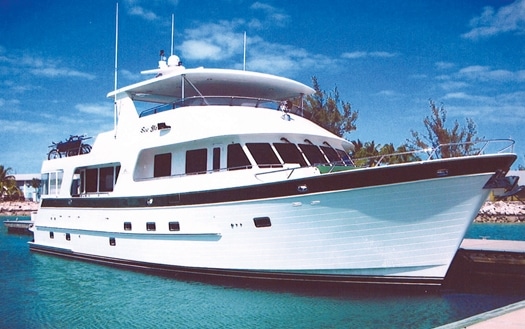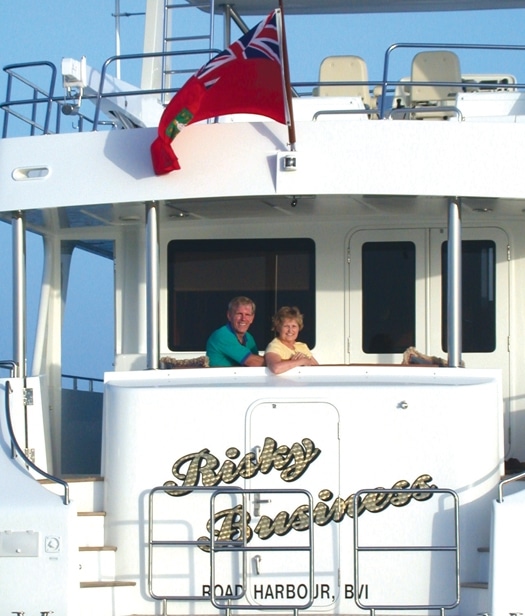
ytgjun09cy2525.jpg
A growing number of yachts are being operated “short-handed,” the nautical term for a voyage with fewer than the usual number of crew members. In the yachting world, it was not long ago that owning a 70-footer meant having a dedicated captain and at least one crew member.
Today, however, there are a growing number of yachts in the 60- to 80-foot range being handled by husband-and-wife teams. And this isn’t just weekend marina-hopping, either, but voyages that stretch the lengths of continents and span oceans.
John and Linda Langan who, in 16 months, have ranged from Alaska to Mexico and are currently in the Caribbean aboard their Nordhavn 47, are now accustomed to short-handed cruising. “At first it was daunting, now it’s no big thing,” they happily report.
A multitude of factors have not only made this possible, but desirable. Modern technology has provided warping winches that can turn a 100-pound woman into Arnold Schwarzenegger when it comes to handling dock lines, while bow and stern thrusters make docking easier. There are more young couples acquiring larger yachts these days, yet not really wanting paid crew. And at the other end, there are “empty-nesters,” who want to be able to take out family or friends occasionally, yet still remain independent.
Regardless of the reasons, boatbuilders are seizing on this new market, creating fleets of yachts aimed at short-handed cruisers. We talked to a number of owner-operators, as well as boatbuilders, to gather some of the hard-won tips and techniques that make short-handed cruising possible. Here’s a look at what we learned.
Pick the Right Yacht
The design features needed for short-handed cruising are a matter of common sense. One of the keys to simplified boat-handling, according to one skipper, is the ability to “be everywhere at once.”
This means you need wide side decks that allow you to move easily from bow to stern, with bulwarks or rails high enough to make movement underway safe. It requires having doors on each side of a pilothouse so the skipper can step out to lend a hand quickly. Look for flying bridge stairs that are conveniently located and safe in all conditions. Inside, a pilot berth or convertible settee might be a good idea, so a second person is close at hand during night passages.
Outfit the Yacht
Once you’ve chosen the yacht, you need to outfit it with short-handing in mind, which generally falls into two categories: Extra power and simplicity.
Docking is always the biggest concern for a husband-and-wife team, but several modern conveniences turn this into a “no worries” area. First, bow and stern thrusters allow the skipper to place the yacht precisely against a dock. Second, warping winches on the stern allow one person to easily move a 40-ton yacht. Third, remote helm controls put the skipper where he can see everything, as well as lend a hand as needed. And last (but certainly not least!), the dawn of Zeus or IPS drive power allows joystick control that can pivot the yacht in any direction and even hold station effortlessly.
For Barry and Alice Allred, the bow and stern thrusters aboard their Outer Reef 65, Risky Business, are a godsend. “Choosing hydraulic progressive Trac thrusters was our wisest investment,” says Barry. “I can place the boat against the dock and then hold it there indefinitely while I help with the docklines.” Progressive thrusters can be left in the thrusting position and, being hydraulic, can be used continuously because they don’t have overheating issues.
Warping winches were named as one of the most popular options by boatbuilders, and several owners noted that using them meant they could easily muscle in a spring line-even against wind and current. They also allow the positioning of the yacht to be done from on board, rather than relying on dock helpers. Lydia Biggie, who has cruised the length of the Eastern Seaboard with her husband, John, aboard their Outer Reef 73, SeeYa, always passes the eye of the dockline ashore, so she can control the length from on board.
The ability of the skipper to operate the engines and thrusters from locations other than the helm was also mentioned as very important by short-handed crews. Options include wing controls hidden in a bulwark outside the pilothouse or on the afterdeck, as well as corded control boxes that can be plugged in at various locations around the yacht. Aboard Risky Business, for example, plug locations include the bow (for anchoring), the stern, and both sides of the bridge.

Ample and properly sized fenders were mentioned as valuable to short-handers, because they protect the yacht until all the lines are secured. Several skippers mentioned that they have premarked fender lines, so they can be secured at a set height before being hung over the side. This is particularly important with large or heavy fenders being handled by a small person.
Another valuable piece of deck gear that short-handers mentioned is “a really long boathook” which can be used for placing looped docklines over pilings or cleats when there are no helpers ashore.
Prep the Crew
If there was one tip given by absolutely every short-handed couple, it was to talk everything through beforehand. “Plan ahead, and take your time,” says Lydia Biggie. “John and I will discuss the order of lines to be given to the dock help, because sometimes it varies.” Aboard Risky Business, Barry Allred also tells his wife which lines to set first, and she passes these directions to the dock helpers.
Both John Biggie and Barry Allred go a step further in their preparations: “I talk to the dockmaster by VHF beforehand,” says Allred, “to find out the exact slip location, the wind or current at that spot, and what’s around my slip. That way there are no surprises.” Lydia Biggie adds, “We find out at least half an hour beforehand what side of the dock we’ll be on, and if they are floating or stationary. That way I can estimate the height and position of the fenders.”
Just as important as crew preparation are crew communications. John Langan is succinct: “We use duplex two-way hands-free communications, and this is a marriagesaver!” Barry Allred also has several pairs of voice-activated Eartec headsets, adding a third unit so his daughter “could hear what was going on” when she was aboard. “These work fine, even in a breeze,” says Allred, noting that they allow two people to work without being in sight of each other.
Anchoring
Lowering and raising an anchor brings a host of new challenges but, again, modern technology and ingenuity simplify the task for short-handers. Barry Allred has anchor controls on his remote controller and, once plugged in at the bow, can direct the whole process as he watches.
Aboard SeeYa, the Biggies use hand signals to communicate from the bow to the pilothouse. “I look at him and signal and call ‘taking the pin out.’ This is the safety pin that prevents the anchor and chain from going down. Now John knows my hands are clear, and it’s okay to lower the anchor. We have one of those neat ‘chain counters’ so he can raise and lower the anchor from the wheel and know how many feet are out.”
The way the Langans aboard the Nordhavn 47 see it, “You can’t be too rich or too thin or have too many anchors. I use 400 feet of 7/16-inch chain and a 105-pound CQR. We set the CQR on the roller nearing the anchorage so that when we let the windlass out, it goes down by itself and my wife counts the 50-foot paint stripes to the required scope.” John adds, “All this I do from the pilothouse, since the windlass can be operated from there, the flybridge, or the bow.”
For raising the anchor, Lydia Biggie has painted three marks on the chain, but hers are near the anchor. “When I see these marks come out of the water, I take over raising the anchor. I can now do this slowly, make sure the anchor is free of sand, oriented properly and, finally, seated properly. Besides, by the time I take over the anchor, John needs to pay attention to steering the boat.”
When it comes to signaling, the Biggies keep it simple. “I point to where the anchor chain is, port or starboard, so John can use the bow thruster to line up the boat with the chain. I use a circular motion with my arm to indicate ‘keep the anchor coming up,’ and I put my hand up in a ‘stop’ motion to end pulling the anchor in.”
Safety
The biggest concern for most short-handers is a man overboard because, with just two people aboard, you only have half a crew to handle a serious crisis.
Most short-handers carry comfortable lifejackets in addition to the U.S. Coast Guard-required PFDs-either in the form of automatic inflatable life vests that don’t constrict movements, or as float coats to wear when weathering colder climates. But many short-handers also admitted that they don’t wear them often enough. “Unless the conditions are really bad,” said one, “we don’t put them on. I know we should, but we’re lazy.”
High bulwarks, double or even triple lifelines, and plenty of rails can create a false sense of security and we’d be remiss if we didn’t recommend that everyone on deck wear a life vest at all times.
Even in the best case scenario, when the MOB is wearing a flotation device, the situation is very dangerous because only one person is left to maneuver the yacht, spot the person in the water, and retrieve the crew. There are a multitude of devices designed to help locate and retrieve a crew member, large or small, from the water, and each has its pros and cons. Some require installations on the yacht, and all should be tested in practice situations with a full crew aboard in calm water. A dark night with your spouse in the water is no time to start reading the instructions.
The most popular MOB device for powerboats is the Lifesling, which comes in several variations but is basically a horseshoe- shaped collar that is thrown to the victim or towed behind the yacht so it can be reached without swimming for it.
It provides buoyancy as well as a secure attachment to the yacht and, when combined with lifting tackle on board, allows a smaller person to hoist a heavy and watersoaked victim on board.
Several short-handers that were interviewed have a basic rule: No one ever goes on deck without being watched. And one added that, when voyaging, they always bring the yacht to a complete stop before a crew member goes on deck.
Barry Allred uses a video camera that covers all the action on the afterdeck. “With that, one of us can be in the pilothouse and still keep an eye on the other if we’re rigging lines or fenders.”
Short-handed cruising a largish yacht may seem intimidating or even scary at first but, with a well-chosen yacht and the right equipment and practice, it can be a grand adventure.
“I wasn’t sure the two of us could do it,” says Barry Allred. “I was wrong it’s great!”









